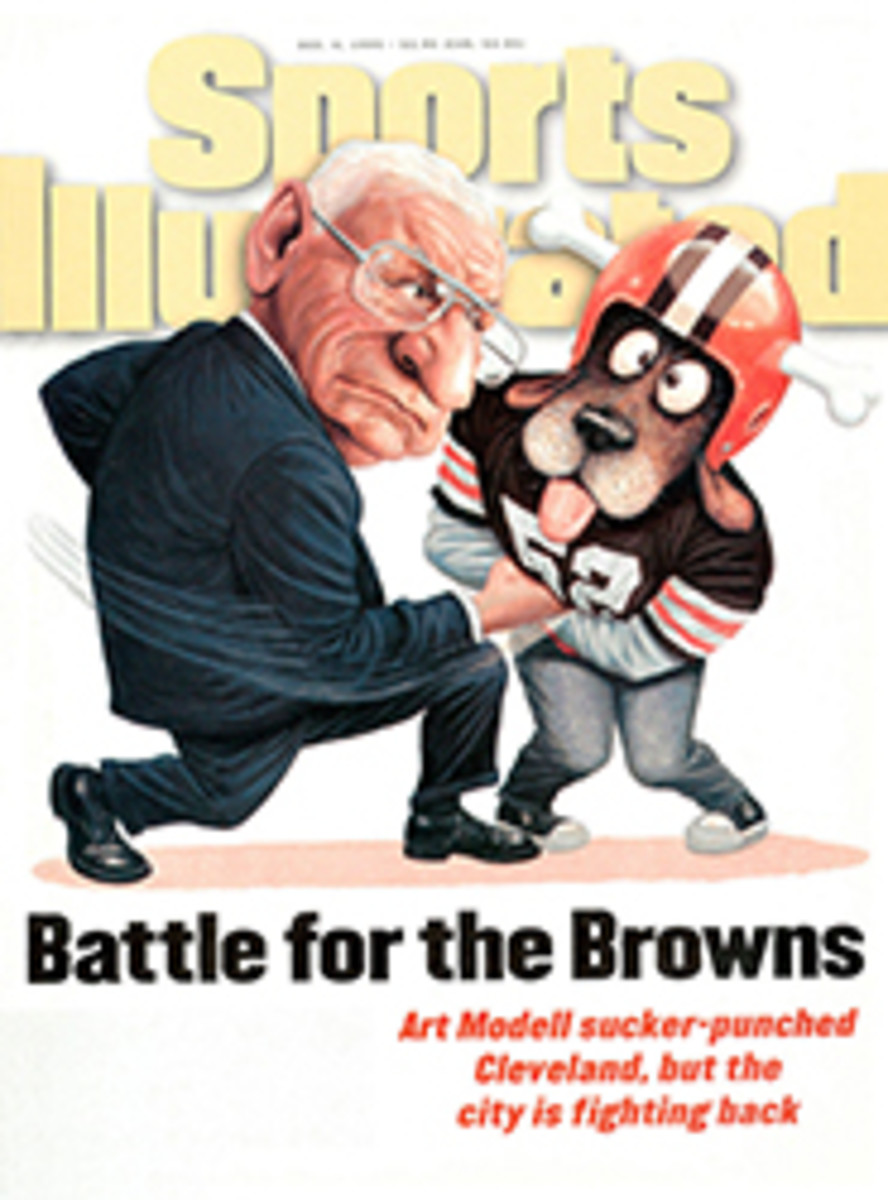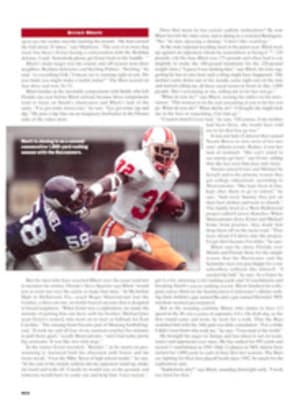
A BUSTED PLAY
Art Modell says that he owes so much money that he has no choice
but to move his Browns to Baltimore because he has reached the
$50 million debt limit the NFL has established for each of its
franchises. In recent weeks Modell has placed the blame for his
precarious finances on local politicians' indifference to his
team's plight and on escalating player salaries. But Modell's
own misguided business decisions are largely responsible for the
mountain of debt he faces.
In an interview with SI on Monday, Modell said that the Browns,
of which he owns 51%, are $40 million in debt and that he is
personally on the hook for $10 million more that he lent to the
team. How is it possible that the Browns, a thriving franchise
by any measure, could be so encumbered that Modell says his only
recourse is to move?
Modell, who bought the Browns in 1961 for $4 million, sowed the
seeds of his team's fiscal demise in '73. That year, he thought
he saw a golden opportunity. The city of Cleveland had been
losing money operating Cleveland Stadium. Modell believed that
if he were to take over the operation of the stadium, he could
reverse those losses. He signed a 25-year lease with the city
that gave him operating control of the stadium beginning in
January '74 and allowed him to rent it to his own team and to
the Indians.
Under the terms of the lease, Modell would receive all the
revenue from the stadium, including income from signage, parking
and concessions. In return he was to pay an annual rent of
$150,000 per year for the first five years and $200,000
thereafter. It was a sweet deal for Modell--so sweet that, while
Modell had several partners in the Browns, he formed a separate
stadium company that he kept mostly for himself. It was sweet
until he was confronted with the grim reality of operating a
crumbling, mammoth 43-year-old stadium.
Modell conceded on Monday that the deal he had struck with the
city "turned out to haunt me." Right away he was forced to
borrow $10 million to fulfill his commitment to install luxury
boxes, a new scoreboard and new rest rooms. But that was only
the beginning. "We wanted to fix up the visiting-team dressing
room," he said Monday. "When we broke the wall down, to our
horror the main structural beam had eroded to the width of a
pencil at its base. So we opened up every wall in the building
to reinforce the structural beams that hold up the upper deck.
Then I knew that I had a real big headache on my hands."
With meager concession revenue from Indian games--"they weren't
drawing fleas, for crying out loud," Modell said--and the
daunting expense of renovations, it wasn't long before Modell's
stadium company began rolling loans into bigger loans. Worse,
Modell told SI, with no stadium revenue to offset the Browns'
operating expenses, the team was forced to begin a separate
cycle of borrowing. And at various times Modell himself borrowed
money from banks that he then lent to the Browns. "I was denying
the football team the resources to be competitive and putting
that money, instead, to pay off my obligations on the stadium
side," he said.
In a 1982 letter to Gabe Paul, then the president of the
Indians, Modell implored Paul to increase the rent that the
Indians were paying. Modell also revealed that his finances were
so bleak that he'd had to give the stadium's concession business
to the Servomation Corporation in exchange for still another
loan to pay off debts.
Yet, while Modell was telling Paul that his stadium company was
a loser, he was trying to persuade his fellow owners of the
Browns to buy it from him. The board of the Browns, which Modell
controlled, voted 4-1 to spend the team's money to purchase the
stadium company. The sale would have produced $4.8 million for
Modell, and his loans would have been assumed by the Browns, an
entity with a healthy cash flow, thanks to NFL revenue-sharing,
which divvies up TV money and gate receipts equally among the
teams. But Robert Gries, who owns 43% of the Browns and cast the
lone vote against Modell's scheme, saw no reason to saddle the
Browns with Modell's bad loans, and he sued to halt the sale.
In the course of his lawsuit, sources say, Gries discovered that
Modell had used $600,000 of his own money to purchase a piece of
real estate (on which Modell had hoped to build a new stadium)
in Strongsville, Ohio, which he later sold to his stadium
company for $3 million. While attempting to unload the stadium
company to the Browns, Modell had claimed that the Strongsville
property was worth $3.8 million. Gries hired an appraiser who
valued the property at $335,000. It took four years, but Gries
prevailed in court, leaving Modell with his stadium company, his
lease and his debts. In 1994 he even lost the Indians, who had
made their own bargain with the city and moved into the new
Jacobs Field.
Modell's most recently reported salary from the Browns--a total
of $632,500 for the three years ending in 1990--is not out of
line for a corporate chief executive. And he says he has not
drawn a salary from his closely held stadium company.
But clearly Modell is still a wealthy man: He owns 51% of a team
that is estimated to be worth $160 million or more. And it's no
wonder he is leaping at the deal he's getting from the state of
Maryland. By 1998 he would have free use of a new stadium in
Baltimore, not to mention close to 100% ownership of his team,
which by then could be valued at more than $200 million.
--LESTER MUNSON
TWO COLOR PHOTOS: PHOTOGRAPHS BY DAVID LIAM KYLE While the faithful thronged Cleveland Stadium--now unadorned by ads--for years (chart), Modell's decision to take control of the arena would prove to be his undoing. [Fans wearing signs reading: "LARRY, CURLY AND MO DELL"; view of fans in Cleveland Stadium]
CLEVELAND BROWNS ATTENDANCE (1975-94)
Year Home Att. League % Record
(Avg.) Rank Capacity
1975 55,777 9 70 3-11
1976 67,515 3 84 9-5
1977 68,686 2 86 6-8
1978 63,756 3 79 8-8
1979 74,228 2 92 9-7
1980 77,562 2 96 11-5
1981 75,216 2 94 5-11
1982 62,829 13 78 4-5
1983 70,580 2 88 9-7
1984 57,304 13 72 5-11
1985 66,969 6 84 8-8
1986 72,967 3 91 12-4
1987 70,420 2 88 10-5
1988 76,943 2 96 10-6
1989 76,677 2 96 9-6-1
1990 71,012 5 89 3-13
1991 71,469 6 89 6-10
1992 70,052 6 89 7-9
1993 71,059 6 91 7-9
1994 69,948 7 89 11-5

